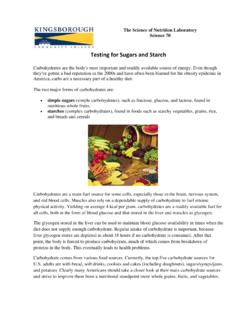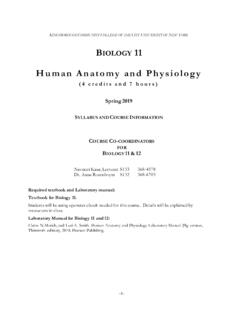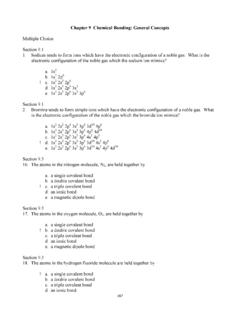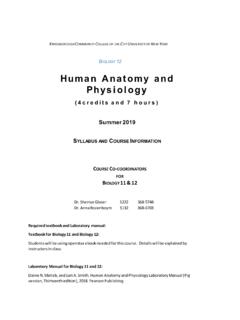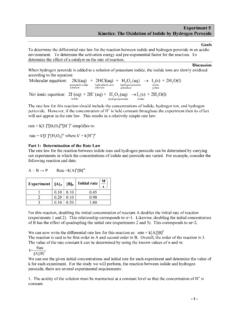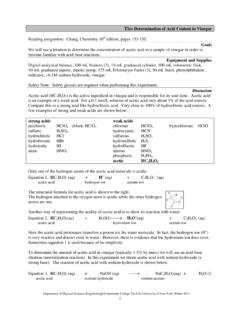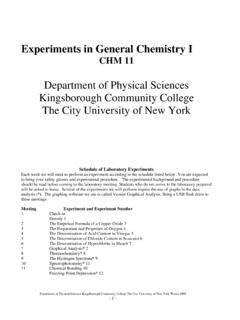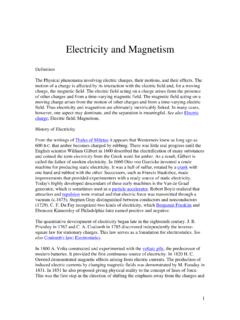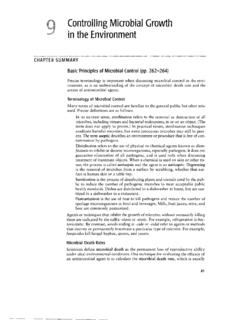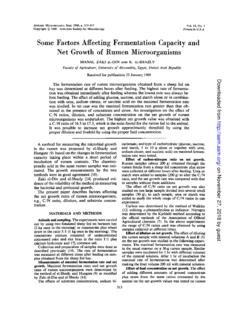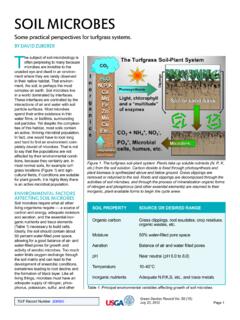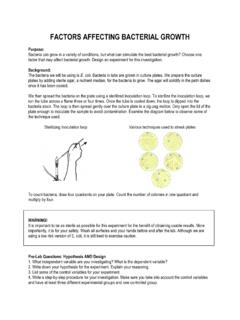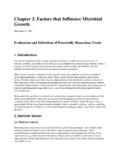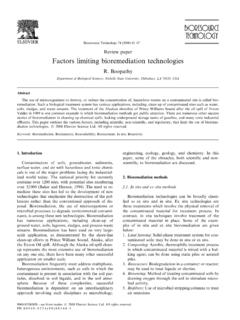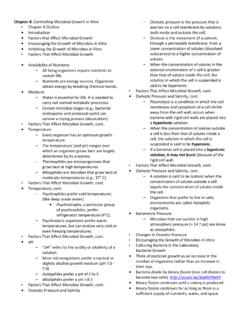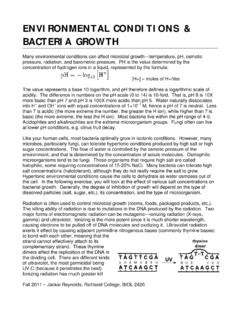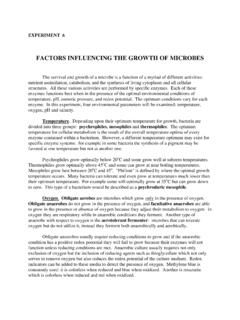Transcription of DEPARTMENT OF BIOLOGICAL SCIENCES BIOLOGY 51: …
1 BIO 51 1. DEPARTMENT OF BIOLOGICAL SCIENCES . BIOLOGY 51: MICROBIOLOGY OF HEALTH & DISEASE. SYLLABUS & COURSE OUTLINE. FALL 2018 - SUMMER 2019. COURSE COORDINATOR: DR. JOHN LOPEZ. (718) 368-5457. BIO 51 2. Course Information Bio 51 is a one semester 4 credit, 6 hour course required for preparing for Nursing, Physician's Assistant and other allied health SCIENCES only. This course examines the role of microbes as infectious agents responsible for a wide variety of diseases and medical conditions. Disease transmission, treatment, and prevent are considered. The laboratory focuses on the basic methods to cultivate, identify and control microbial growth . This course does not satisfy the BIOLOGY major elective requirement. Prerequisites: successful completion of Bio 12. Science 25 (required for nursing students only). Corequisites: For nursing students only, Bio 51 must be taken before or with Nursing 21.
2 Nursing students cannot continue in Nursing 21 if they withdraw from Bio 51. Course Overview Major diseases caused by microorganisms are considered. These include: HIV. opportunistic and nosocomial infections, tuberculosis, hepatitis, pneumonia, sexually transmitted diseases, and water and foodborne diseases. The course has direct application to medical surgical nursing. Universal precautions, asepsis, and control of microbial growth are emphasized. Immune responses to infections are discussed. Your knowledge of anatomy and physiology will be applied to understand the effects of microbial infections on various organs systems. If you are unsure of any of the anatomy and physiology principles being discussed, please review them or meet with your instructor. Course Goals for Student Outcomes 1. Apply the concept of asepsis and its applications to laboratory procedures, hospitals, &.
3 Medical practices. 2. Employ basic principles of microbial anatomy and physiology to microbial virulence, pathogenicity, and disease establishment. 3. Identify the factors affecting microbial virulence and the responses by the host's defense mechanisms. 4. Determine properties of microorganisms through staining and biochemical testing that can be used for diagnostic microbial identification. 5. Recognize the signs and symptoms of particular disease and decisions involved in determining antibiotic therapy. BIO 51 3. Recommendations to Students Read assigned lecture and laboratory material before coming to class. Ask questions and meet your instructor during office hours to clarify any questions you may have. Attendance to class is essential. If you do miss class you are responsible for making up the missed work. A student in any course who has been absent 15% of the total number of instructional hours that a class meets during a semester is deemed excessively absent.
4 Excessive absences may result in the instructor assigning either a lower grade or WU grade for the course. For Bio 51, this policy is brought into effect when a student exceeds approximately 11 hours of class time. Plan your work and study time. Read over or perhaps rewrite your notes after class. Read the text to supplement your notes. Discuss the material with your classmates. Form study groups. Best wishes for your success in the course. If you have any questions, please feel free to meet with your instructor. Access-Ability Services (AAS) serves as a liaison and resource to the KCC. community regarding disability issues, promotes equal access to all KCC. programs and activities, and makes every reasonable effort to provide appropriate accommodations and assistance to students with disabilities. Please contact this office if you require such accommodations and assistance.
5 Your instructor will be glad to make the accommodations you need, but you must have documentation from the Access-Ability office for any accommodations. Academic Integrity Your instructor upholds the KCC policy on academic honesty (see Student Handbook online). There are serious consequences for cheating on exams or plagiarizing someone else's work ( , turning in work that is copied from another source). These include a reduced grade or zero, suspension, or dismissal. If you are not sure what constitutes academic dishonesty, please check with the instructor. Plagiarism is the use of others' words and/or ideas without clearly acknowledging their source. As students, you are learning about other people's ideas in your course texts, your instructors' lectures, in-class discussions, and when doing your own research. W hen you incorporate those words and ideas into your own work, it is of the utmost importance that you give credit where it is due.
6 Plagiarism, intentional or unintentional, is considered academic dishonesty and all instances will be reported to the Academic Judiciary. To avoid plagiarism, you must give the original author credit whenever you use another person's ideas, opinions, drawings, or theories as well as any facts or any other pieces of information that are not common knowledge. Additionally, quotations of another person's actual spoken or written words, or a close paraphrasing of another person's spoken or written words, must also be referenced. Accurately citing all sources and putting direct quotations of even a few key words in quotation marks are required. BIO 51 4. Grade computation: Lecture and laboratory are each 50% of the final grade. Lecture Examinations- 21%. Writing assignment- 9%. Final examination- 20%. Textbook and Laboratory Manual Black, Microbiology: Principles and Explorations.
7 9th edition (2008) John Wiley &. Sons (Recommended). Brancaccio-Taras, L. Laboratory Exercises in Microbiology. 2nd edition (2007) Whitter Publications: New York. (Required). **Special requirements: a) Knee length laboratory coat: This requirement conforms to OSHA safety regulations. It must be worn at all times in the microbiology laboratory. You will not be able to remain in the laboratory without a lab coat. After each week's lab, the lab coat should be washed. b) Safety goggles: eye protection needs to be worn when you are handling cultures. Eyeglasses cannot be used in lieu of safety goggles. BIO 51 5. BIO 51 LECTURE OUTLINE. WEEK 1: INTRODUCTION AND HISTORY OF MICROBIOLOGY. Organisms studied in microbiology (prokaryotic and eukaryotic). The nature microbiological problems The history of microbiology Reading Assignment- Chapter 1 p. 1-26. WEEK 2: BACTERIAL ANATOMY.
8 Bacterial shapes and arrangements Cell wall Cell membrane Glycocalyx Endospores Flagella Cytoplasmic inclusions Cytoplasmic structures/organelles Reading Assignment- Chapter 4 p. 77-96; Chapter 6 165-166; (Review of eukaryotic organelles Chapter 4 p. 97-104). WEEK 3: BACTERIAL GENETIC TRANSFER & growth . 3 major modes of bacterial genetic transfer: transformation, conjugation, & transduction Significance of genetic transfer Bacterial cell division Bacterial growth curve Reading Assignment- Chapter 8 p. 213-224; Chapter 6 p. 146-150. WEEKS 4 & 5: BACTERIAL METABOLISM. Aerobic respiration Anaerobic respiration Fermentation and types of fermentation Use of metabolic properties to identify microorganisms Industrial uses for microbial metabolism- food, antibiotic, and enzyme production Antibiotic therapy Reading Assignment- Chapter 5 p. 115 135; Chapter 13 p. 371-400.
9 WEEKS 5 & 6: IMMUNOLOGY. Normal flora, transient flora opportunistic microbes Pathogenicity, virulence, and factors that increase virulence (enzymes, toxins). factors that affect the spread of disease Nonspecific immune responses Specific immune responses: humoral and cell mediated immunity Vaccines HIV/AIDS. Reading Assignment- Chapter 14: p. 405 425; Chapter 15: p. 433 462;. Chapter 16: p. 472 493; Chapter 17: p. 498 533; Chapter 18: p. 564 571. BIO 51 6. WEEKS 7 & 8: microbial DISEASES OF THE SKIN AND EYES. Bacterial diseases of the skin Acne, folliculitis, boils, furuncles, carbuncles, impetigo, cellulitis, & osteomyelitis Infections of burns and surgical wounds, gangrene Leprosy Viral Diseases of the Skin Warts Chicken pox and shingles Herpes (HSV I). Measles German measles (Rubella). Smallpox Fungal Diseases of the Skin Dermatophyte infection (Tinea infections).
10 Candidiasis Bacterial diseases of the Eyes Conjunctivitis Atypical bacterial diseases of the Eyes Inclusion conjunctivitis Trachoma Viral Diseases of the Eyes Herpetic Keratitis Reading Assignment: Chapter 19: p. 585 606. WEEKS 8 & 9: microbial DISEASES OF THE RESPIRATORY SYSTEM. Bacterial diseases Group A streptococci, its complications (rheumatic fever, glomerulonephritis) & scarlet fever Diphtheria Otitis media Laryngitis, sinusitis & bronchitis Bacterial pneumonia Pertussis Tuberculosis Legionnaire's disease Atypical bacterial diseases Ornithosis Mycoplasmal pneumonia Reading Assignment: Chapter 21: p 650-684. BIO 51 7. WEEKS 8 & 9: microbial DISEASES OF THE RESPIRATORY SYSTEM. Bacterial diseases (Continued). Viral diseases Common cold Influenza Viral pneumonia (Respiratory Syncytial Infection). Hanta virus pulmonary syndrome Fungal diseases Histoplasmosis Cryptococcosis Pneumocystis carinii pneumonia Reading Assignment: Chapter 19 p.

